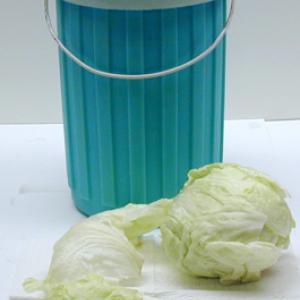College of Liberal Arts & Sciences
4A40.30 - Liquid Nitrogen - Ball, Rubber Tube, and Lettuce
See also 4A40.30 in Heat and Fluids
Arrange ahead of time to get liquid nitrogen from Biochem stores. Typically it takes about 4 liters for each classroom demonstration.
Dip the rubber hose into the nitrogen for a time and it will shatter like glass when struck against the lecture bench.
If you want to raise some eyebrows you can put a hot dog into one of the finger holes of a glove and then put the glove on. Dip your hand and the glove so that only the hot dog finger is submerged and then pull out your hand and hit it on the table breaking the hot dog and making people think you have just frozen and broken a finger.
Freeze the tennis ball innards and when thrown against the floor or wall it will shatter like glass.
Grapes when frozen will bounce much like steel ball bearings.
Lettuce and flowers may also be frozen in liquid nitrogen and when touched they will crumble like potato chips when you crush them.
The temperature of liquid nitrogen should be a -196o C or approximately 77o K.
A table of boiling points for some common liquids and gasses:
FLUID Boiling Pt. (K) Boiling Pt. (C)
Water 373 100
Propane 231.3 - 41.8
CO2 (sublimates) 194.6 - 78.6
Methane 111.6 - 161.6
Oxygen 98.2 - 183
Argon 87.3 - 185.8
Nitrogen 77.4 - 195.8
Neon 27.1 - 246.1
Hydrogen 20.3 - 252.9
Helium 4.2 - 268.9
Absolute Zero 0 - 273.1
- Kathy Maline, Tejwant Datta, "Beware the Frozen Squash Ball", TPT, Vol. 32, # 6, Sept. 1994, p. 351.
- Floyd Holt and George Amann, "Cryogenics", TPT, Vol. 28, # 5, p. 321, May 1990.
- R. G. Hunt and G. L. Salinger, "Qualitative Demonstrations and Experiments Using Liquid Nitrogen", TPT, Vol. 7, # 5, May 1969, p. 289
- Hk-7, 8: Freier and Anderson, A Demonstration Handbook for Physics.
- H-078: "Objects in Liquid Nitrogen", DICK and RAE Physics Demo Notebook.
- Russell J. Hemley, George W. Crabtree, and Michelle V. Buchanan, "Materials In Extreme Environments", Physics Today, November 2009, p. 32.
- 50 Fun Experiments for the Mad Scientist in You, "Frozen Bounce", National Geographic Kids, p. 115.
- Julien Clinton Sprott, Physics Demonstrations, "2.9, Liquid Nitrogen", p. 88, ISBN 0-299-21580-6.
- Jearl Walker, "4.31, Dead-Cat Bomb and a Frozen Disappearance", The Flying Circus of Physics Ed. 2, p. 190.
- 10: "Liquid Nitrogen", Chemical Demonstrations, Vol. 2, pp. 20-21.
- Jeff Merritt, "Some Ideas for Demonstrations Using Nitrogen", PIRA News, Vol. 10, No 2, November 1995.
- Gordon McComb, Lasers, Ray Guns, & Light Cannons - Projects from the Wizard's Workbench, pp. 28.
- Borislaw Bilash II, “Cryogenic Malleability“, A Demo A Day – A Year of Physical Science Demonstrations, p. 30.
Disclaimer: These demonstrations are provided only for illustrative use by persons affiliated with The University of Iowa and only under the direction of a trained instructor or physicist. The University of Iowa is not responsible for demonstrations performed by those using their own equipment or who choose to use this reference material for their own purpose. The demonstrations included here are within the public domain and can be found in materials contained in libraries, bookstores, and through electronic sources. Performing all or any portion of any of these demonstrations, with or without revisions not depicted here entails inherent risks. These risks include, without limitation, bodily injury (and possibly death), including risks to health that may be temporary or permanent and that may exacerbate a pre-existing medical condition; and property loss or damage. Anyone performing any part of these demonstrations, even with revisions, knowingly and voluntarily assumes all risks associated with them.

